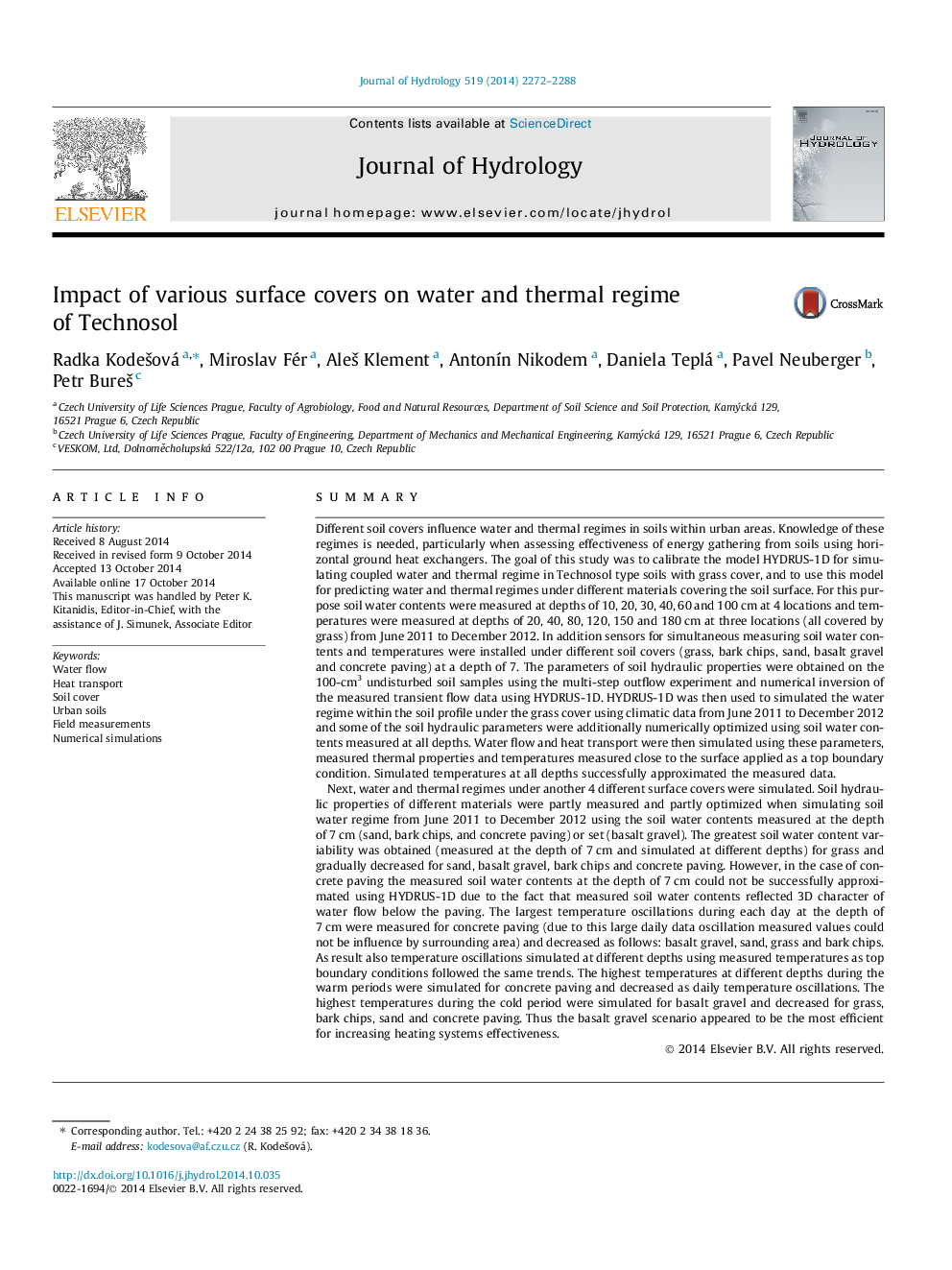| کد مقاله | کد نشریه | سال انتشار | مقاله انگلیسی | نسخه تمام متن |
|---|---|---|---|---|
| 6412104 | 1332896 | 2014 | 17 صفحه PDF | دانلود رایگان |

- Water and thermal regime in Technosol with grass cover was monitored.
- Both regimes were successfully simulated using the HYDRUS-1D code.
- Impact of different soil surface covers on soil thermal regime was studied.
- Different temperatures were measured at the depth of 7Â cm under different covers.
- Simulations proved different temperatures to the depth of 180Â cm.
SummaryDifferent soil covers influence water and thermal regimes in soils within urban areas. Knowledge of these regimes is needed, particularly when assessing effectiveness of energy gathering from soils using horizontal ground heat exchangers. The goal of this study was to calibrate the model HYDRUS-1D for simulating coupled water and thermal regime in Technosol type soils with grass cover, and to use this model for predicting water and thermal regimes under different materials covering the soil surface. For this purpose soil water contents were measured at depths of 10, 20, 30, 40, 60 and 100Â cm at 4 locations and temperatures were measured at depths of 20, 40, 80, 120, 150 and 180Â cm at three locations (all covered by grass) from June 2011 to December 2012. In addition sensors for simultaneous measuring soil water contents and temperatures were installed under different soil covers (grass, bark chips, sand, basalt gravel and concrete paving) at a depth of 7. The parameters of soil hydraulic properties were obtained on the 100-cm3 undisturbed soil samples using the multi-step outflow experiment and numerical inversion of the measured transient flow data using HYDRUS-1D. HYDRUS-1D was then used to simulated the water regime within the soil profile under the grass cover using climatic data from June 2011 to December 2012 and some of the soil hydraulic parameters were additionally numerically optimized using soil water contents measured at all depths. Water flow and heat transport were then simulated using these parameters, measured thermal properties and temperatures measured close to the surface applied as a top boundary condition. Simulated temperatures at all depths successfully approximated the measured data.Next, water and thermal regimes under another 4 different surface covers were simulated. Soil hydraulic properties of different materials were partly measured and partly optimized when simulating soil water regime from June 2011 to December 2012 using the soil water contents measured at the depth of 7Â cm (sand, bark chips, and concrete paving) or set (basalt gravel). The greatest soil water content variability was obtained (measured at the depth of 7Â cm and simulated at different depths) for grass and gradually decreased for sand, basalt gravel, bark chips and concrete paving. However, in the case of concrete paving the measured soil water contents at the depth of 7Â cm could not be successfully approximated using HYDRUS-1D due to the fact that measured soil water contents reflected 3D character of water flow below the paving. The largest temperature oscillations during each day at the depth of 7Â cm were measured for concrete paving (due to this large daily data oscillation measured values could not be influence by surrounding area) and decreased as follows: basalt gravel, sand, grass and bark chips. As result also temperature oscillations simulated at different depths using measured temperatures as top boundary conditions followed the same trends. The highest temperatures at different depths during the warm periods were simulated for concrete paving and decreased as daily temperature oscillations. The highest temperatures during the cold period were simulated for basalt gravel and decreased for grass, bark chips, sand and concrete paving. Thus the basalt gravel scenario appeared to be the most efficient for increasing heating systems effectiveness.
Journal: Journal of Hydrology - Volume 519, Part B, 27 November 2014, Pages 2272-2288